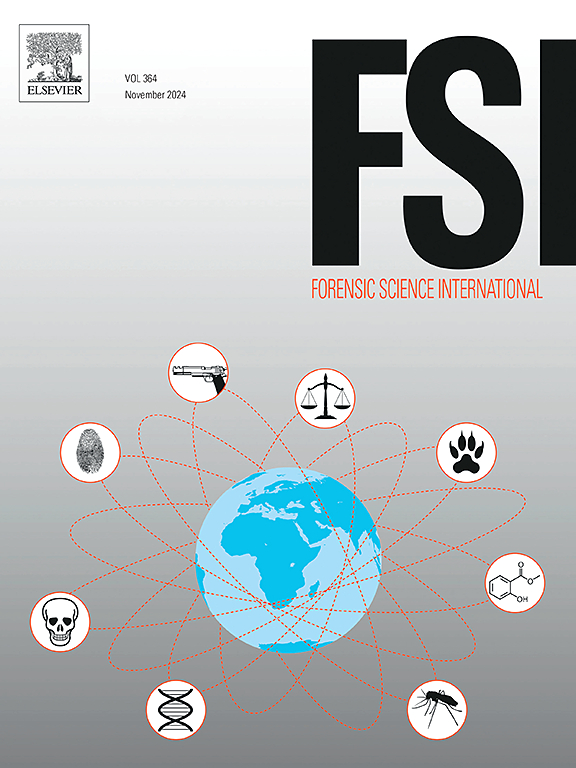(Re-)positionning forensic research & development for increased impact in gunshot residue examination
IF 2.5
3区 医学
Q1 MEDICINE, LEGAL
引用次数: 0
Abstract
Despite its relatively high cost and time-consuming analysis, scanning electron microscopy coupled with energy dispersive X-ray spectroscopy (SEM-EDS) has been the “gold standard” technique for analysing inorganic gunshot residue (GSR) particles for more than 40 years. Conversely, research has largely focused on developing new techniques and innovations that have struggled to gain acceptance in routine GSR examination.This study aims to explore the persistent gap perceived between research and practice in the field of GSR, specifically why research continues to propose novel instrumental analyses that are not adopted in practice. This question was examined through a comprehensive literature review, a survey of GSR examination, and a round table organised at the annual meeting of the European Network of Forensic Science Institutes (ENFSI) Expert Working Group (EWG) Firearms / GSR in Brussels in 2023.The literature review highlighted that publications on GSR have steadily increased over the past 20 years, followed by a slight decrease after 2020 to reach approximately 40 publications in 2022. In that year, 42 % of the relevant publications focused on the development of novel methods, while 26 % addressed issues related to GSR persistence, prevalence, and interpretation.Survey responses from 45 GSR experts confirmed that residues are mainly collected from hands with carbon stubs and analysed by SEM-EDS. Among respondents, 90 % work in accredited laboratories, and 95 % have little time for research beyond routine duties. While practical innovations have largely concentrated on the optimisation of current approaches, experts strongly support collecting additional forensic data on persistence, prevalence, and secondary transfer. However, such data often suffer from a lack of harmonisation and are only indirectly useful for the interpretation, which is gradually shifting from source to activity inferences.Both practitioners and academics advocate for increased collaboration to define and conduct more impactful GSR research. However, addressing the identified barriers may require systemic changes that go beyond simply increasing resources.
(重新)定位法医研究和发展,以增加在枪弹残留检查中的影响
扫描电子显微镜与能量色散x射线能谱(SEM-EDS)相结合,尽管其分析成本相对较高且耗时较长,但40多年来一直是分析无机射击残留物(GSR)颗粒的“金标准”技术。相反,研究主要集中在开发新技术和创新上,这些技术和创新很难在常规GSR检查中获得认可。本研究旨在探讨GSR领域的研究与实践之间持续存在的差距,特别是为什么研究不断提出新的工具分析,而这些工具分析在实践中没有被采用。通过全面的文献综述,对GSR检查的调查,以及2023年在布鲁塞尔举行的欧洲法医科学研究所网络(ENFSI)专家工作组(EWG)火器/ GSR年度会议上组织的圆桌会议,对这个问题进行了研究。文献综述强调,在过去20年中,关于GSR的出版物稳步增加,随后在2020年后略有减少,到2022年约为40篇。在那一年,42% %的相关出版物关注于新方法的发展,而26% %的出版物关注与GSR持久性、普遍性和解释相关的问题。来自45位GSR专家的调查回复证实,残留物主要是从带有碳根的手上收集的,并通过SEM-EDS进行了分析。在受访者中,90% %在认可的实验室工作,95% %在日常工作之外几乎没有时间进行研究。虽然实际的创新主要集中在优化现有方法上,但专家们强烈支持收集关于持久性、患病率和二次转移的额外法医数据。然而,这些数据往往缺乏协调,对解释只有间接的用处,而解释正逐渐从来源转向活动推断。从业者和学者都主张加强合作,以定义和开展更有影响力的GSR研究。然而,解决已确定的障碍可能需要系统性的变革,而不仅仅是增加资源。
本文章由计算机程序翻译,如有差异,请以英文原文为准。
求助全文
约1分钟内获得全文
求助全文
来源期刊

Forensic science international
医学-医学:法
CiteScore
5.00
自引率
9.10%
发文量
285
审稿时长
49 days
期刊介绍:
Forensic Science International is the flagship journal in the prestigious Forensic Science International family, publishing the most innovative, cutting-edge, and influential contributions across the forensic sciences. Fields include: forensic pathology and histochemistry, chemistry, biochemistry and toxicology, biology, serology, odontology, psychiatry, anthropology, digital forensics, the physical sciences, firearms, and document examination, as well as investigations of value to public health in its broadest sense, and the important marginal area where science and medicine interact with the law.
The journal publishes:
Case Reports
Commentaries
Letters to the Editor
Original Research Papers (Regular Papers)
Rapid Communications
Review Articles
Technical Notes.
 求助内容:
求助内容: 应助结果提醒方式:
应助结果提醒方式:


